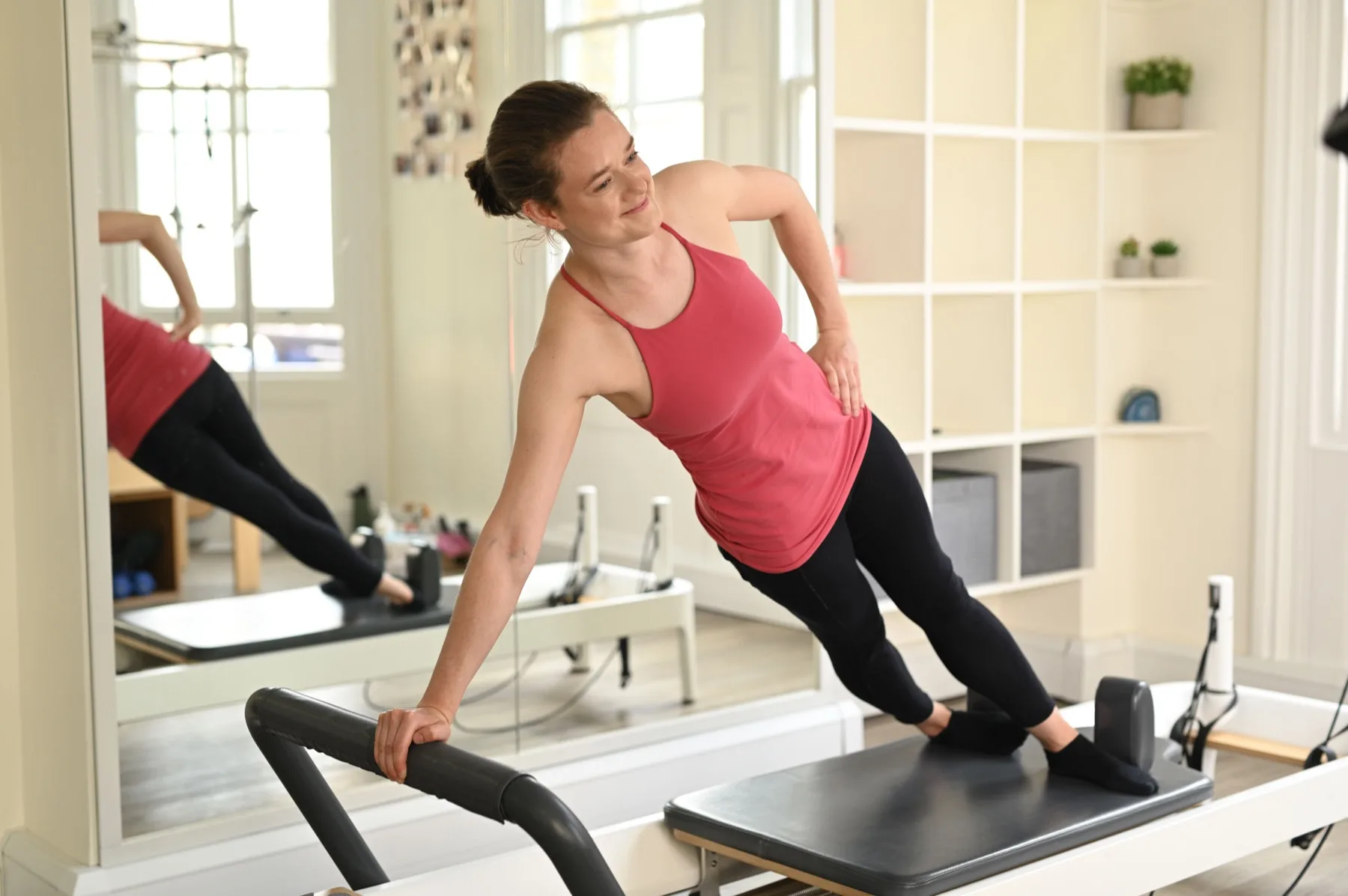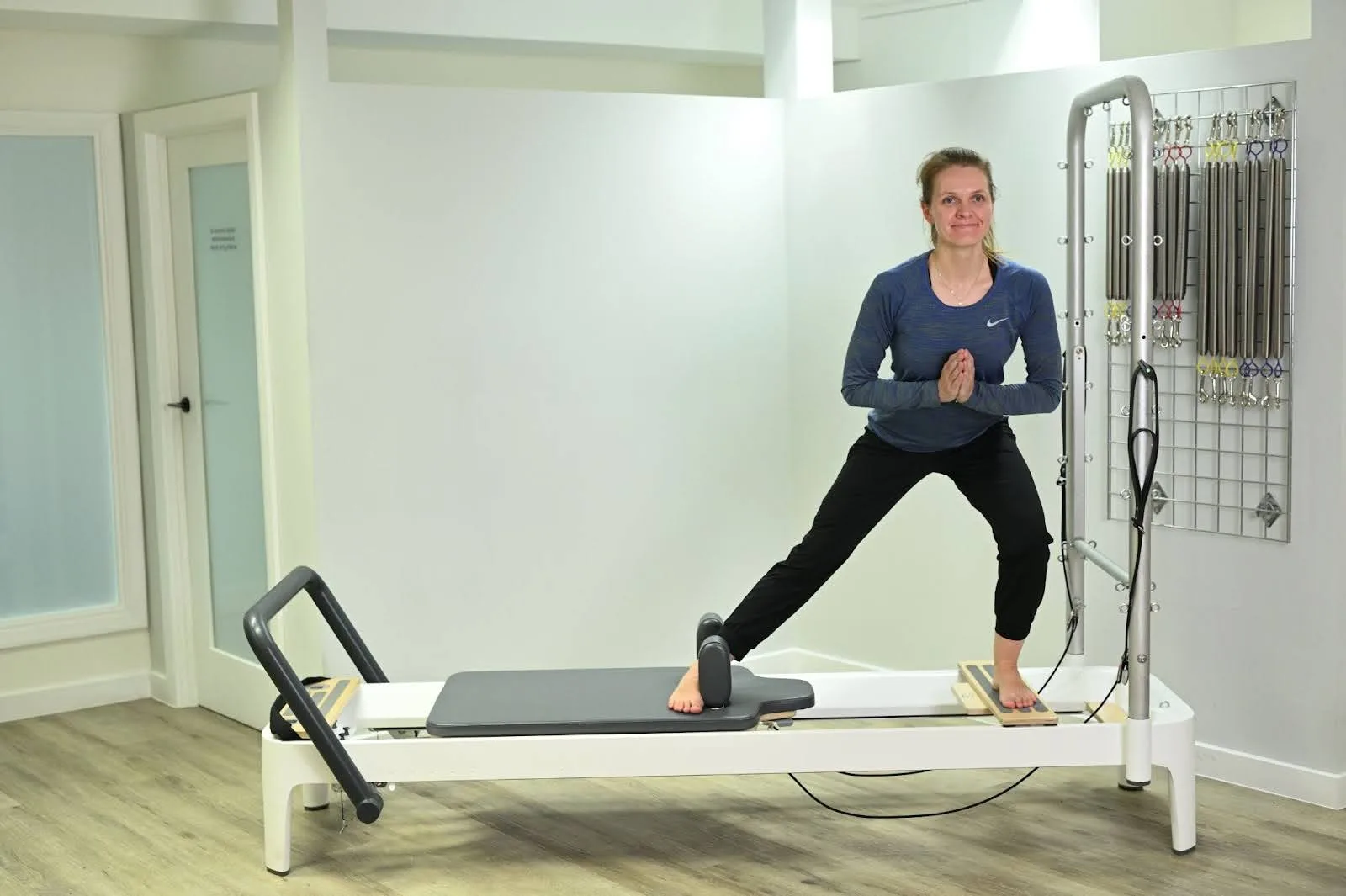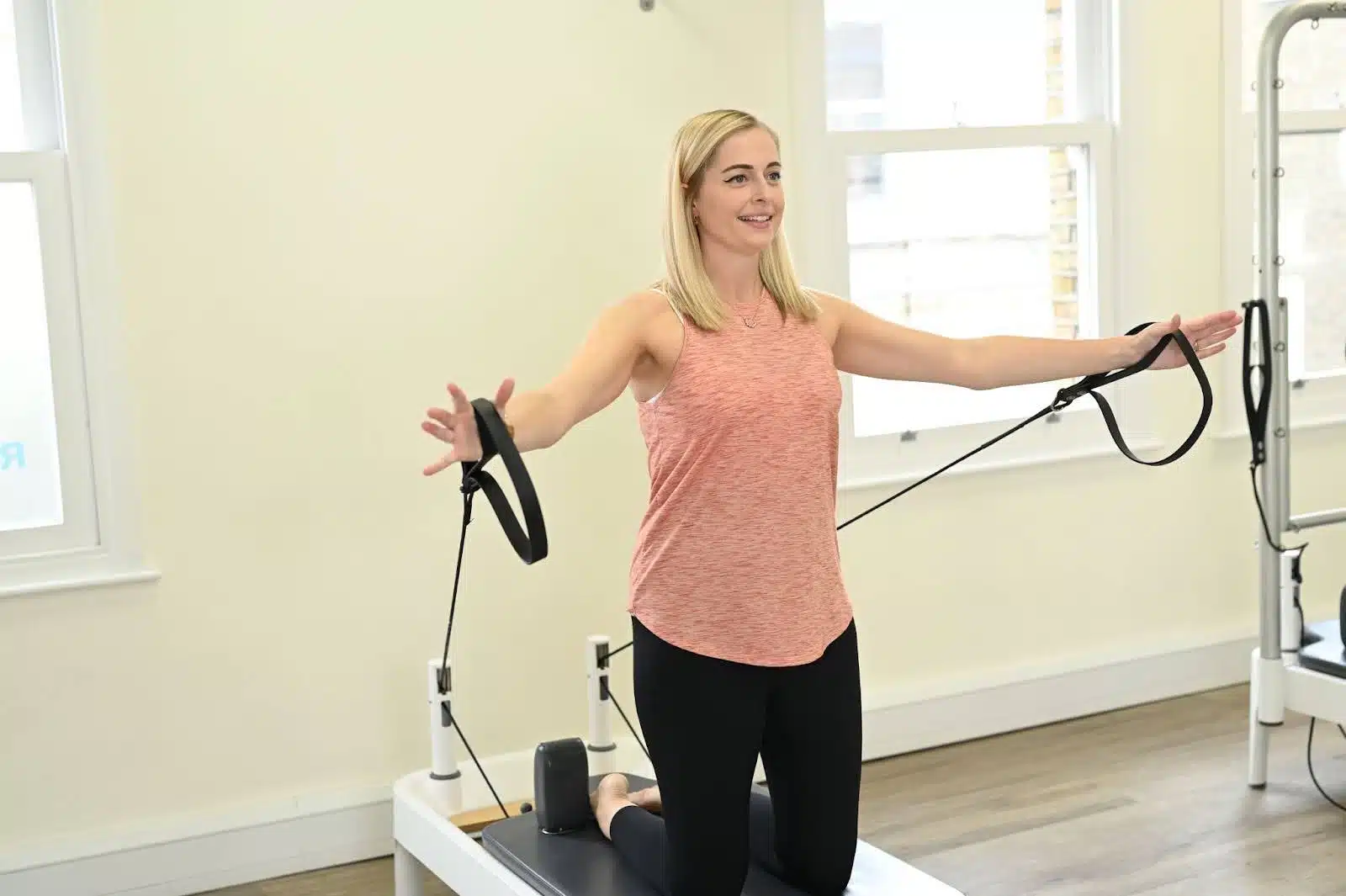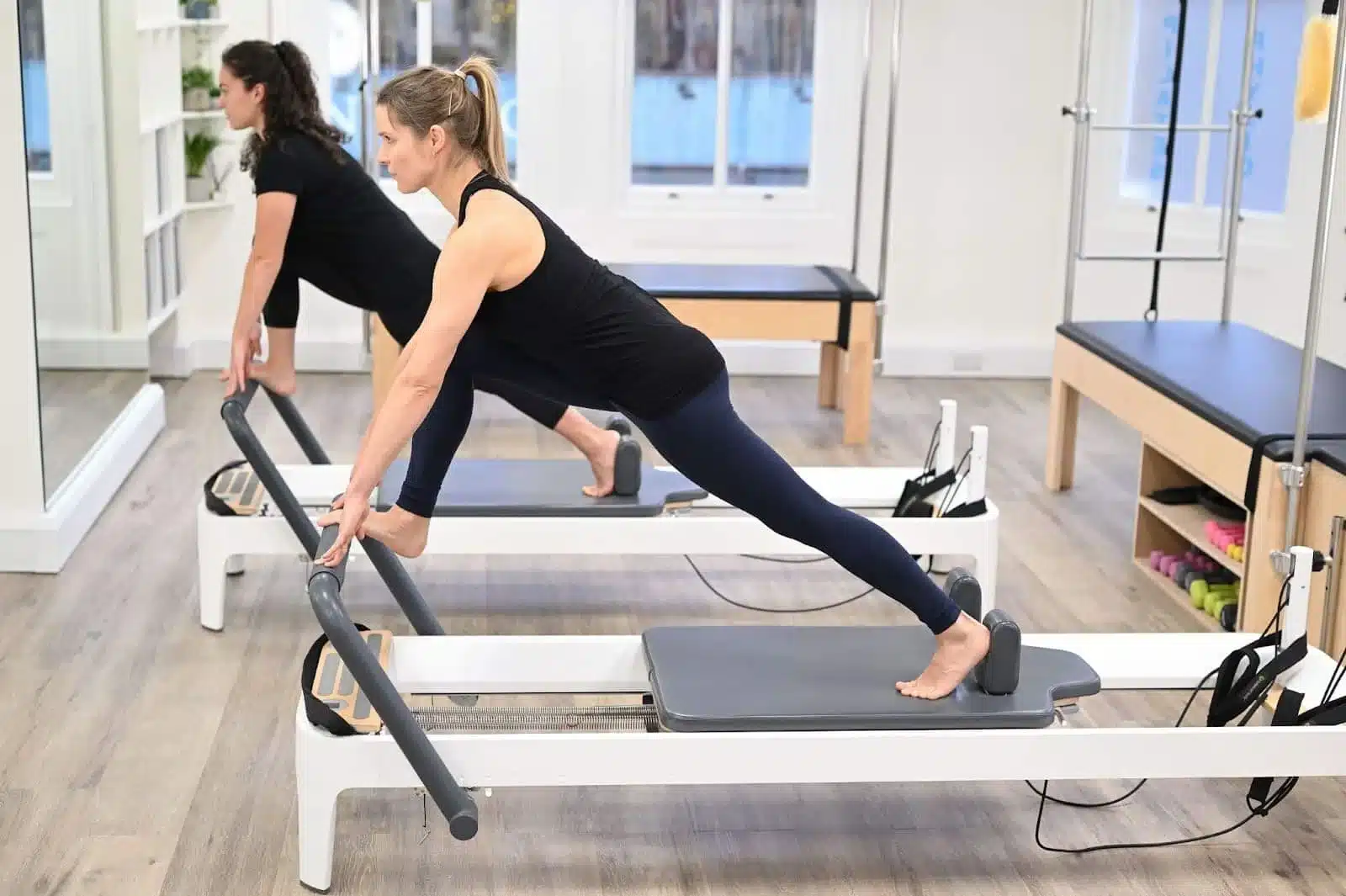Key Contributor: Susie Martin, Chartered Physiotherapist
Co-Contributors: Yael Shtrul, Clinical Pilates Instructor
Introduction
You may have become aware that reformer Pilates classes seem to be popping up everywhere. Now that it is so popular, you may be wondering whether you should try it!
Perhaps you’ve heard people raving about the effects of reformer Pilates on their body and are keen to experience it, but want to know whether it really is worth it. You may be wondering how soon you will see results from reformer Pilates.
However, as with any exercise, how effective it is is dependent on a number of factors! These include regular practice, effort, consistency and a commitment over a period of time.
Whether you get ‘results’ from your reformer classes also depends on your own individual goals. What are you looking for from reformer Pilates? Is it strength, flexibility or something else?
Joseph Pilates is often quoted as saying “after 10 sessions you’ll feel the difference, after 20 sessions you’ll see the difference, and after 30 sessions you’ll have a whole new body”.
Was he right? We explore here….
Key Takeaways
- Reformer Pilates is a great way to improve all over body strength, stability, flexibility, balance and co-ordination – all in one class!
- Reformer Pilates, as with any other exercise, should be practiced several times a week, over several months to see noticeable improvements in your body.
- If you are looking for the fastest improvements, you should practice consistently, look overall at your lifestyle habits, such as sleep, diet and other exercise, and work with a fully qualified Pilates teacher, for expert instruction.
What results can you expect from Reformer Pilates?
So what should you be expecting to change from practicing Reformer Pilates?
Strength
A lot of exercises practiced on the reformer are classed as resistance training, which is the type of training that builds strength. Exercises such as “footwork” work the leg muscles through range which is great for building overall strength. Other exercises such as “long stretch” and “jackrabbit” involve static holds (known as isometric strength) which is great for building stability at the joints.
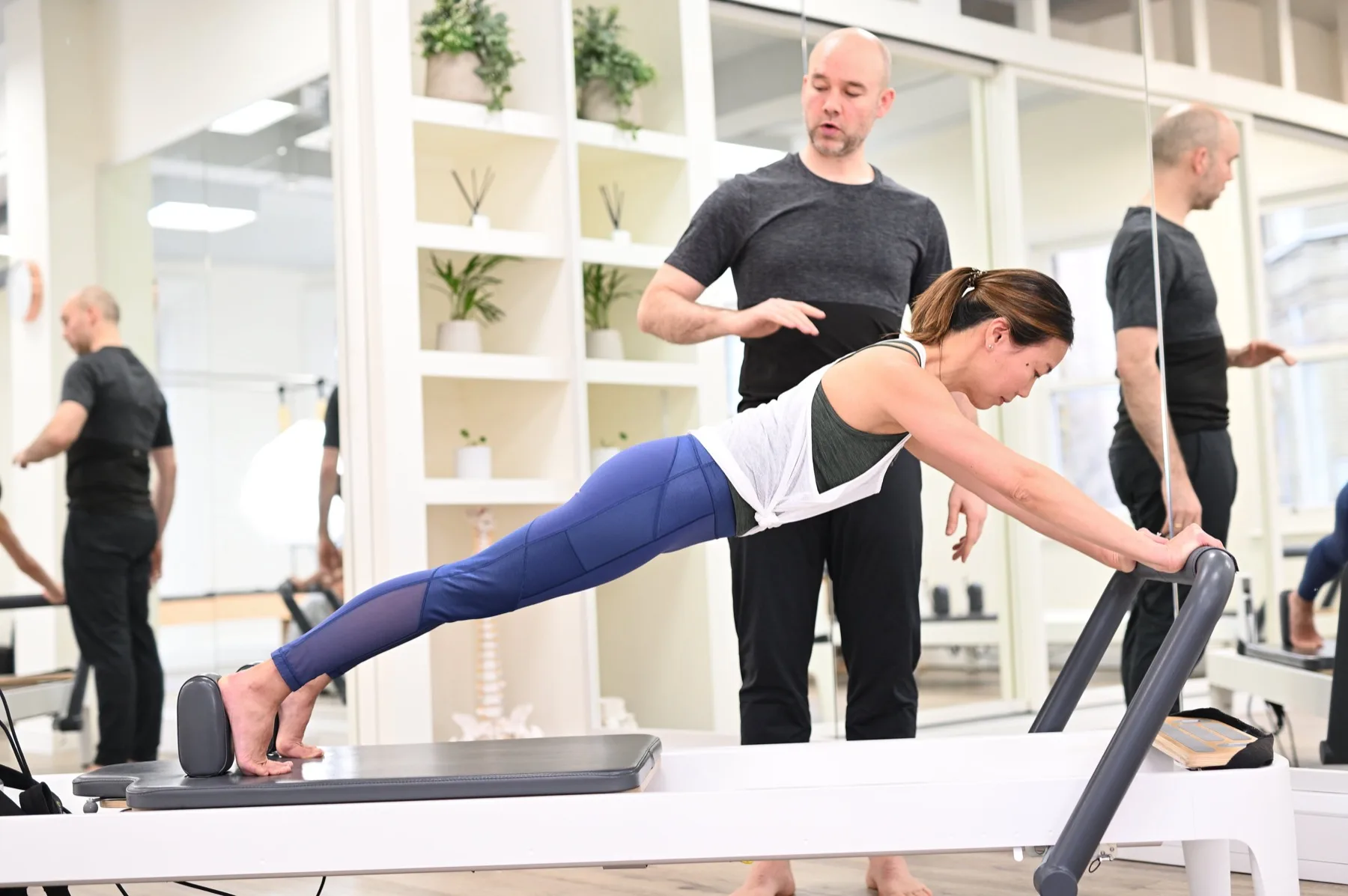
Another type of strength that is used on a reformer is known as ‘eccentric’ strength, which is where you are lengthening your muscles under tension – typically when you are slowing down the carriage movement and resisting the springs. Eccentric movements not only work on strength but also create length and flexibility in the muscles.
Whilst the reformer helps build all over body strength, it is particularly well known for its repertoire of exercises that help to strengthen the abdominals and back muscles.
With an increase in strength, people often start to notice that they have more muscle definition, or a general sense that their muscles feel more firm.
Stability
Many of the exercises on the reformer help you to build stability in your body. Exercises such as feet in straps, help you learn how to stabilise your pelvis and lower back whilst your legs are moving. Exercises such as “knee stretches”, “long stretch” and “star” help you to stabilise your back and pelvis as well your shoulder muscles.
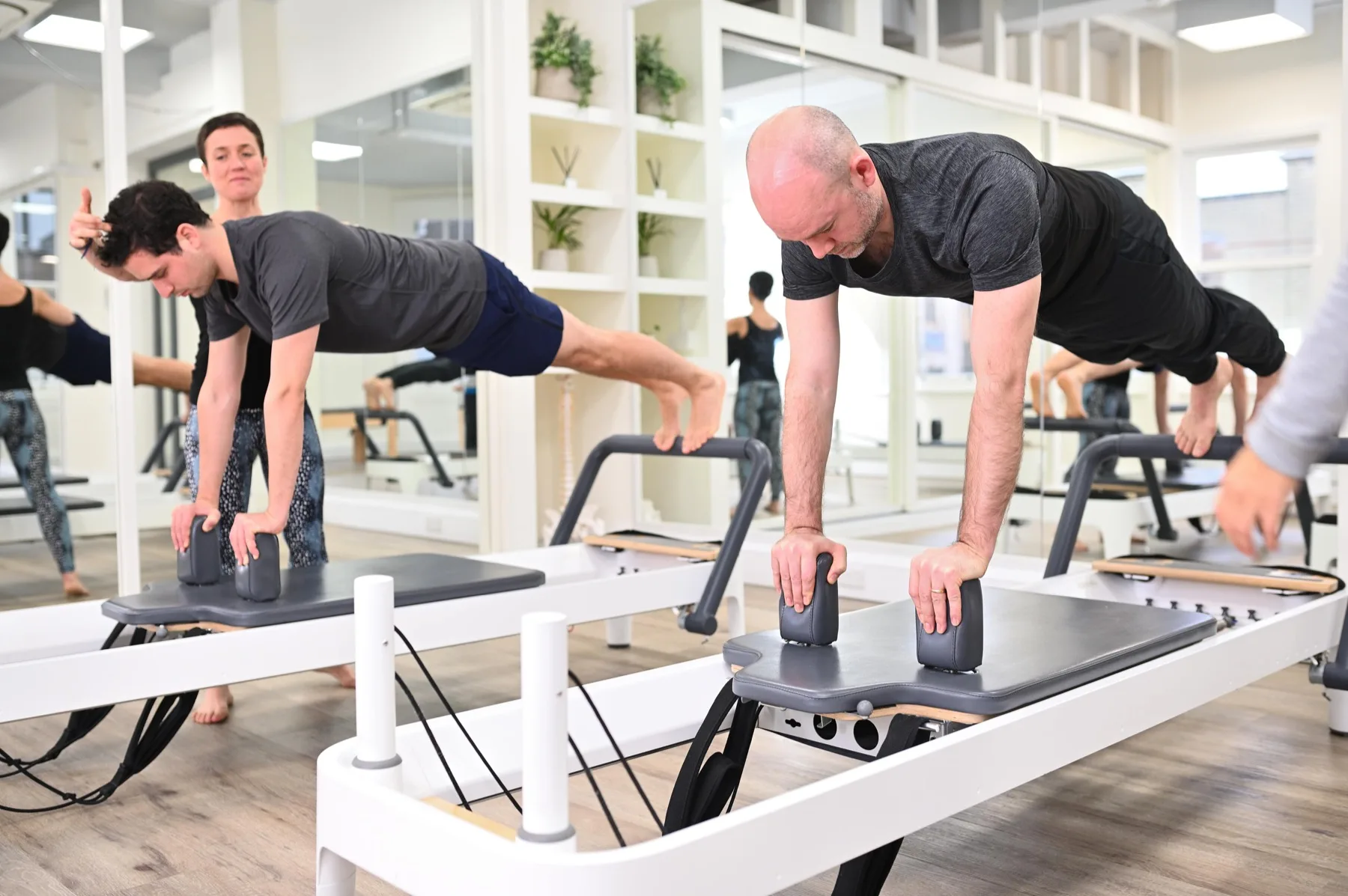
Mobility
Many of the reformer exercises are brilliant working on mobility of your joints and in particular your spinal mobility.
For example the “mermaid” on the reformer is a great way to mobilise the spine into side bending, and mobilising the shoulder joints as well.

Balance
Exercises such as the “scooter” and “standing side splits”, are great for working on your balance in a really dynamic way. The sliding carriage on the reformer provides the perfect way to challenge balance in new ways.

During scooter, you balance on one leg whilst propelling the carriage with the other, whereas in standing side splits you stand on the reformer footplate and press the carriage away sideways, which challenges your balance in a different way.
Co-ordination
Reformer Pilates involves some complex movement patterns – you are often moving arms and legs at the same time, which might feel easy when you are walking…but when you are in a different position relative to gravity, suddenly this becomes a challenge!
A lot of the exercises have ‘choreography’ where you might be moving your arms or legs in opposite directions (known as reciprocal movement), which is a brilliant exercise for getting the different halves of the brain to communicate to each other.
You might be focussing on keeping one body part still whilst moving the adjacent body part – which is not as easy as it sounds! This is known as ‘isolation’ or ‘dissociation’ and there is a lot of it in Pilates!
If that were not enough, you might then be focussing on coordinating movement through the whole body, in a particular sequence and timing, to get an effect from the exercise. The exercises “Co-ordination” and “Upstretch” are brilliant for this.
Improved body awareness
The design of the reformer provides a lot of opportunity for your body to receive feedback as you are doing exercises. The carriage underneath your body provides tactile feedback for your spine as you roll down from a bridge or the “short spine” exercise.
The sound of the carriage moving tells you that you might be moving too fast, your goal being to have the carriage move as silently as possible. The straps, handles and bar, give you feedback through your hands and feet.
The ease with which you move in an exercise can also provide feedback. Suddenly an exercise that felt challenging in a previous session can suddenly become much easier or feel more satisfying, when you nail the correct technique. This gives you an understanding of how to optimise your movement patterns, which you can transfer into any type of exercise.
A sense of wellbeing
Finally, Joseph Pilates himself, believed that a healthy body made for a healthy mind. He believed that Pilates was exercise for the mind, body and spirit. In more recent years, the research evidence very much supports the idea that physical health is important for mental health. We know that the body’s natural painkilling chemicals (endorphins) and feel good neurotransmitters (serotonin) are released through vigorous exercise.
In addition the focus on breath during Pilates can help to improve the mechanical efficiency of breathing, but it can also help us to slow breathing, which helps to reduce activity of the body’s stress system – the sympathetic nervous system. Finally, there is also some evidence that contracting your core muscles helps to reduce anxiety!
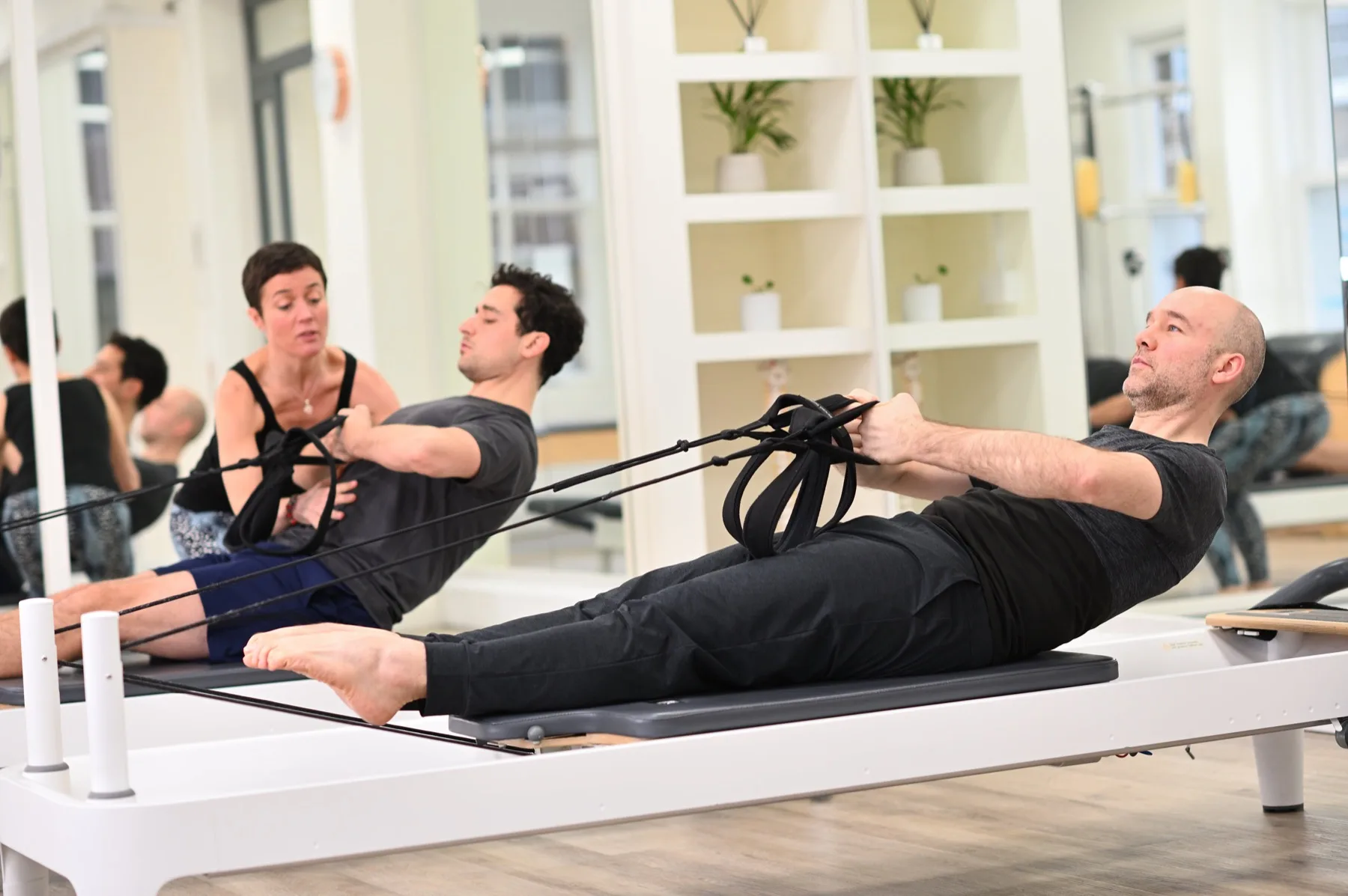
What do our experts say?
‘’What I love about Pilates is that it truly is for everyone. I see the practice as an opportunity to pause, step away from the noise of daily life, and take a moment to really listen to your body. When we begin to tune in and get to know ourselves more deeply, that’s when real change happens.
Whether you practice to reduce pain, build strength, improve mobility, or simply to move and feel good, Pilates can be adapted to meet you exactly where you are. I like to think that we do Pilates to live better, not just to get better at Pilates.’’ Yael Shtrul
How soon can you see results?
0 – 2 weeks
Improved body awareness – doing Pilates is often the first time that people might have noticed the way that their body moves, so for some people, improved awareness starts straight away. However, this is an ongoing process, so you will normally notice new things every few sessions.
A sense of wellbeing – a sense of wellbeing is apparent for most people when they first try reformer Pilates – it’s one of the things that keeps people coming back! This, coupled with a sense of having done a challenging workout combines to create an exhilarating feeling.
Mobility and flexibility – people often find that they feel much more mobile when they finish a reformer Pilates session.
2 – 6 weeks
Balance, stability and co-ordination
As your body starts to experience the repetition of the exercises and routine, your brain is learning new movement patterns and routines. Your brain’s ability to send messages to the body improves, and these messages get faster.
6 – 12 weeks
Strength and Improving Flexibility
As well as continued improvements in your balance, stability and co-ordination, you now start to get the benefits of continued practice and repetition. The continued improved speed of brain to muscle messaging, results in stronger muscle contractions, and you will start to feel stronger. You may also start to notice visual changes in your body, with some muscle definition creeping in.
Often you may start to notice that you find it easier to hold yourself in a more upright posture as your spinal mobility improves and the strength of your back muscles begins to increase.
12 weeks and beyond
Strength
With ongoing training and commitment, you will generally start to consistently build strength over the longer term. After 12 weeks of resistance training, the muscles can start to change their structure, increasing the number of muscle fibres. This means that they can generate more force, and have the potential to increase in size.
However, this can vary from person to person. If you are looking for muscle definition, it is important to note that this is also dependent on additional factors, which include your genetic makeup, nutrition and body fat content.
It is difficult to say how soon you might see results, since it depends on the results you are looking for! However, here is a rough guide to what you might expect to notice….
How many times a week should you do Pilates to get results?
| Aim | Number of sessions |
|---|---|
| Minimum requirement for improvements | 1 – 2 sessions per week |
| Moderate improvements | 2 – 3 sessions per week |
| Significant improvements | 3 – 4 sessions per week |
How many times a week you should do Pilates to get results depends on a few different factors.
As a beginner, it is advisable to start with 1 – 2 sessions per week, in order to get your body accustomed to new movement patterns, and to leave space for recovery and to see how your body responds. If you are not used to movement you may find this challenging enough.
Once you are managing this level of activity with ease, or if you are an intermediate mover, 2 – 3 sessions per week would likely see you noticing real improvements in all areas.
For those who are already very fit, 3 – 4 sessions per week would deliver noticeable improvements.
If you are doing quite high intensity reformer Pilates it is important to allow yourself recovery days, so generally doing more sessions per week will not add further gains to your routine.
Tips for seeing results faster
Consistency
Reformer Pilates is no different to any other type of training routine – the number one tip for seeing improvements in your strength and mobility is regular sessions and consistency over a long period of time.
If you are doing lots of sessions in sporadic bursts, this will be less effective than fewer sessions that you can commit to sustaining over a long time.
If attending regular Reformer sessions isn’t possible for you, then substituting some sessions with strength training at home or in the gym will help you to reach your strength and fitness goals.
Healthy Nutrition
If you are looking to gain strength through your Pilates workouts, or you want to lose weight, then you will need to consider appropriate dietary intake.
Protein is the building block of muscle, so adequate protein intake is necessary for gaining strength. Losing weight in a healthy manner, whilst preserving healthy lean tissue, cannot be done without a healthy diet. Consider consulting nutrition specialist for advice that is customised to you.
Rest and recovery
Many people fall into the trap of thinking that all of the positive changes that happen in the body when you adopt a new exercise routine are happening during the time that you exercise. However, these changes are actually taking effect during the times that you are not exercising!
Rest days are really important, to allow your body to do the job of building muscle. Not only that, but rest is also necessary for the brain to process new movement patterns, when you are learning a new physical skill.
Sleep has a very important role in helping you build muscle, as the hormones that help you build new tissue are released when you are asleep. Not only this, but a full night’s sleep is required for those hormones to be released.
If you are feeling fatigued in spite of exercising regularly, or you are starting to pick up niggling injuries or infections – pay attention to your training routine and make sure you have factored in necessary rest.
Work with the right kind of instructor
Reformer Pilates is experiencing something of a boom at the moment, however, there are many differences between the different types of settings.
Do your research to find out what kind of class is right for you and make sure that your instructor has proper training, with a recognised Pilates training institute. Those properly trained in Pilates can give you detailed feedback about your form, so that you get the most out of your exercises.
A good Pilates instructor can also adjust the exercise repertoire to help you meet your goals. If you want to strengthen your arms and legs, this will require different spring settings on the reformer, compared to those you might choose for building abdominal strength.
FAQs
Can I see results by doing Reformer Pilates once a week?
Yes, you can see results by doing reformer Pilates once a week. However, doing reformer Pilates 2 – 3 times per week is optimal to help improve your strength, stability, flexibility, balance and control.
Is Reformer Pilates enough to tone your body?
Firstly, let’s address the myth that ‘toning’ exists. What most people mean by this is muscle definition, which is a very modern aesthetic.
Muscle definition is achieved by a combination of increased lean muscle mass and very low body fat. This combination can only really be achieved by strength training and diet together. There may also be an element of genetics in body composition.
Reformer Pilates is effectively a form of strength training, and particularly well known for its ability to train your abdominals and core strength.
Many people do notice improvements in their muscle definition when they do Reformer Pilates but this is very individual. Some people will see visual changes in their body composition and others may need to try other types of strength training exercise, with more emphasis on heavier loads for the arms and legs. The best way to know is to do it!
Whilst Reformer Pilates may not change body composition for everyone, there are many other brilliant benefits to this exercise. Reformer Pilates will improve your strength and flexibility at the same time but also challenge your body in completely different ways to other types of exercise. It’s also incredibly fun!
How much is too much reformer Pilates?
You can never have too much reformer Pilates! OK, so we are a bit biased here at Complete Pilates….but here’s the truth….
The answer to this question partially lies within your own body, since listening to your body is the best way to know if you are doing too much. Exercising regularly with Pilates should generally lead to you feeling stronger, more mobile and energised. If you are working out at an advanced level with very heavy resistance and a lot of body weight exercise, you may also feel some post exercise muscle soreness, which is normal, and generally goes away after a couple of days.
However, if you are exercising multiple times a week but your energy levels are low and you feel fatigued, you may be doing too much. You may also start to pick up infections or injuries, a sign that your immune system is under stress.
If this is the case, it is a good idea to reduce the number of sessions and / or the intensity of those sessions, so that your body has a chance to recover. The beauty of reformer Pilates is that there is so much variety in the exercises that you can still do a session, but it is very easy to change the focus to lower load exercises and exercises with a mobility focus, which could be done every day.
Conclusion
Reformer Pilates is a fabulously fun way to move, and can improve your strength, flexibility, balance and coordination all at once. It is particularly effective for training abdominal strength but this is not the only strength benefit!
Many will notice improvements in their strength and mobility within a few sessions of starting reformer Pilates. Others may start to notice visible changes in their body within the first 12 weeks. However, these types of changes may also be dependent on other factors, such as diet and lifestyle and intensity of working out.
Feeling inspired?
At Complete, we specialise in one to one reformer and equipment Pilates. If you want to experience high quality reformer Pilates with one of our expert instructors, book a session at one of our London studios today.
Our physiotherapist-led reformer Pilates studios in Chelsea, our Angel reformer Pilates studio and our reformer Pilates studio in the City, offer a highly tailored approach to your Pilates training, whether your goal is to manage a health condition, rehabilitate from an injury or to improve your strength and fitness.
Get in touch with us via email or contact us on 0203 764 5668 for further information.
Education is key:
These blogs are designed to give information to everyone, however, it is important to remember that everyone is different! If you have not seen one of our therapists and have any questions about injuries, what you have read or whether this may be useful to you, please just ask. We are more than happy to help anyone and point you in the right direction. Our biggest belief is that education is key. The more you understand about your injury, illness and movement, the more you are likely to improve.


